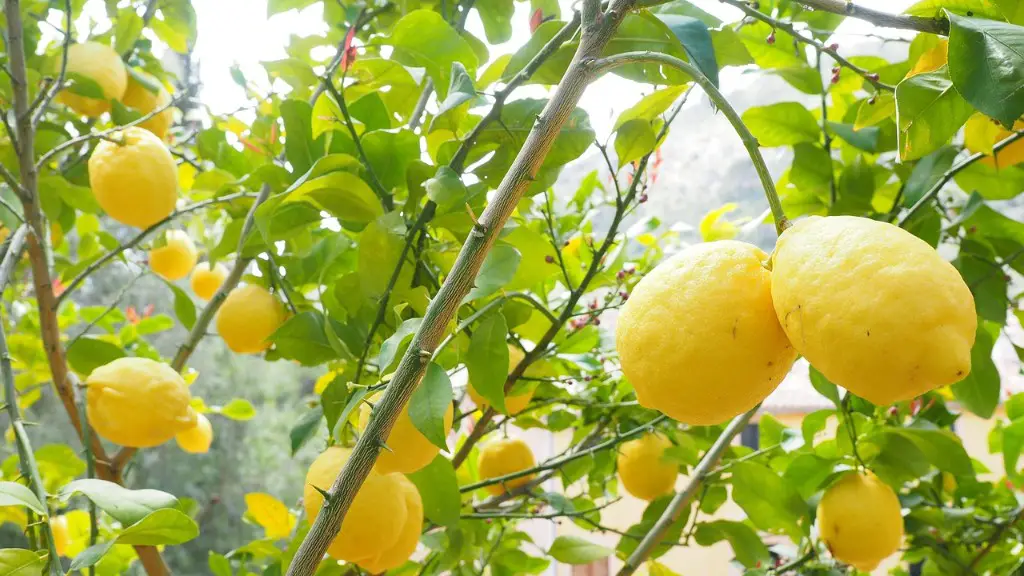Lemon trees are prolific producers of citrus fruits, but they can grow out of control. That’s when it’s time to prune the tree. Pruning helps to shape the tree, removes unproductive or dead wood, prevents disease, and encourages healthy and productive fruiting. To properly cut back a lemon tree, one needs to have the knowledge, proper tools, and the patience.
To start, one needs to familiarize themselves with the fruiting and growing characteristics of a lemon tree. Appreciating the tree’s form, when it fruits, how often, how long it takes to mature, and how long it takes to bear fruit aids in shaping the tree. Next, one must gather the necessary tools and safety equipment to complete the job: pruning shears or loppers, long-handled pole pruning shears or saw (for higher branches); work gloves and a hat for sun protection.
In preparing to prune the tree, one needs to analyze the whole structure of the tree, identify dead, diseased, or damaged limbs and branches, alongside with possible crisscrossing branches and sprouts. Mature trees can benefit from thinning out to allow light and air to reach the center, whilst creating a strong framework of more productive branches.
Once the pruning has begun, it is important to avoid the tendency to trim too much. Pruning does not always encourage more fruit, but can lead to damage and harm. Similarly, if fruit is present, one must be careful to identify and leave only the right sized fruit. The right sized fruit should be ripe, but hard still, and appear full and unblemished. When pruning branches, one must make sure to cut just outside the branch bark collar, where the branch meets the trunk or main limb, which encourages the tree to heal correctly.
Finally, lemon tree pruning is an ongoing process. After the initial trim, one needs to leave around 4 inches of new growth and follow up with regular maintenance. For optimal health, one should strive to perform an annual spring pruning and winter pruning every year. With patience and knowledge, one can have a healthy, productive lemon tree.
Pruning for yield
When it comes to pruning a lemon tree for optimal yield, it’s important to know the fruiting habits of a lemon tree. Lemon trees usually bear fruit once annually, which is known as the primary crop, followed by a few crops of small fruits during the course of the year. Thus, when cutting back a tree, one needs to be mindful to not over prune, which can reduce the yield of the primary crop.
Thus, it is recommended that in the summer, after the primary crop has been harvested, one should prune, removing limbs or branches that are in the way of normal maintenance tasks and thinning out any dense areas of the tree. This will help to open up the tree’s canopy and will help to prevent disease and promote sunlight penetration at ground level.
If the tree is producing too much fruit and the yield is diminishing, it is advisable to increase the spacing time between the primary and secondary crops. This can be done by pruning the secondary fruits at fruit set, which can prevent the tree from overbearing in the future. Again, the goal is to achieve an open canopy and a healthy balance between wood and fruit.
Overall, when cutting back a lemon tree, one should keep in mind the common goal: to achieve a balanced tree. This means that the tree must be pruned such that it has an open canopy to allow for light penetration into the center of the tree and leave the right sized fruits on the tree.
Cutting back dead wood
Pruning a lemon tree also involves identifying, cutting off, and removing dead, diseased, or damaged limbs and branches. This practice is important for healthy growth, as dead branches can harbour disease, parasites, or even pests, which can spread to neighbouring branches, ruining the whole tree. It is also important to remove any crisscrossing branches, which can create points of stress on the tree, reducing fruit quality and encouraging diseases.
To carry out this task, one needs to start by identifying the dead and damaged branches as these are usually easy to spot as they are brittle and have no leaves. Once the dead wood has been identified, one must cut it off without delay; use sharp and clean equipment to prevent any infections on the tree. It is crucial to cut just outside the branch bark collar, which is the area where the branch meets the trunk or main limb. One should also make sure to leave a stub of around 1-2 cm in order to otherwise prevent further damage.
Once the dead wood has been removed, one must also cut off any potential sprouts growing around the base of the tree, making sure not to leave any stubs as these can act as nurseries for fungal pathogens and lead to the spread of disease.
Once the dead wood and crisscrossing limbs have been removed, one is left with a select few limbs and branches that are strong, disease free, and free of any pests. From here, one can proceed on to more detailed shaping and pruning.
Controlling growth
In terms of controlling growth, it is important to understand the natural shape and ratios of a lemon tree. Lemon trees have a classic vase shape; a single main trunk with a series of limbs or branches that create a cone-like shape. When pruning, one must work towards creating this shape, as it promotes productiveness of the tree and ensures long-term health of the plant.
When pruning, one should pick out the most productive and healthy branches that are long, thick, and evenly spaced around the tree. These should be retained while pruning off the smaller, weaker branches. This will help to establish a healthy, stable framework that will bear fruits in the future. One should also be mindful of removing any crisscrossing branches or limbs sprouting around the trunk.
At the same time, one should avoid pruning too much, as this can bring about a reversed effect; disrupting the balance and damaging the tree. One should leave between 4 to 6 inches of new growth on each branch tip after the trimming, which will ensure the longevity of the tree. If there is too much new growth, one should prune it off in a way that does not affect the overall framework and productivity of the tree.
Achieving balance
In gathering the knowledge and performing the pruning, one must always strive to achieve balance. Prune the tree to create an optimal ratio between wood and fruit; not too much of one or the other. This balance should be equal in both the primary and secondary crops. It is important to remember that pruning too much can decrease productivity, whilst over-fruiting also affects productivity.
Prune the tree such that it allows for light and air penetration into the center of the tree. At the same time, prune such that it keeps the tree’s form in balance; not too upright or bent out of shape. Overly pruning the top and sides will result in an unappealing appearance. Overall, the goal is to ensure that the tree is healthy, fruit-bearing, and aesthetically pleasing.
Additionally, it is important to prune the tree such that it maintains a favorable fruit size; ripe but not too ripe or too small. Heavy pruning can lead to excessive fruit production and too small fruits. This can reduce the yield of the main crop and increase competition among the fruits, leading to a reduced marketability.
Conclusion
When it comes to pruning a lemon tree, it is important that one understands the fruiting of the tree as well as the practical aspects of pruning. Gather clean and sharp equipment, and be patient when working through the process. Prune for balance and structure, remove dead wood, and thin out densely fruiting areas. And, most importantly, give the tree a chance to heal by making sure to cut the branch tips just outside the branch bark collar.





